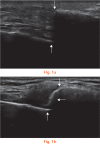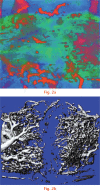What is the role of ultrasound in fracture management?: Diagnosis and therapeutic potential for fractures, delayed unions, and fracture-related infection
- PMID: 31463038
- PMCID: PMC6691369
- DOI: 10.1302/2046-3758.87.BJR-2018-0215.R2
What is the role of ultrasound in fracture management?: Diagnosis and therapeutic potential for fractures, delayed unions, and fracture-related infection
Abstract
Objectives: The aim of this study was to review the current evidence and future application for the role of diagnostic and therapeutic ultrasound in fracture management.
Methods: A review of relevant literature was undertaken, including articles indexed in PubMed with keywords "ultrasound" or "sonography" combined with "diagnosis", "fracture healing", "impaired fracture healing", "nonunion", "microbiology", and "fracture-related infection".
Results: The use of ultrasound in musculoskeletal medicine has expanded rapidly over the last two decades, but the diagnostic use in fracture management is not routinely practised. Early studies have shown the potential of ultrasound as a valid alternative to radiographs to diagnose common paediatric fractures, to detect occult injuries in adults, and for rapid detection of long bone fractures in the resuscitation setting. Ultrasound has also been shown to be advantageous in the early identification of impaired fracture healing; with the advent of 3D image processing, there is potential for wider adoption. Detection of implant-related infection can be improved by ultrasound mediated sonication of microbiology samples. The use of therapeutic ultrasound to promote union in the management of acute fractures is currently a controversial topic. However, there is strong in vitro evidence that ultrasound can stimulate a biological effect with potential clinical benefit in established nonunions, which supports the need for further investigation.
Conclusion: Modern ultrasound image processing has the potential to replace traditional imaging modalities in several areas of trauma practice, particularly in the early prediction of impaired fracture healing. Further understanding of the therapeutic application of ultrasound is required to understand and identify the use in promoting fracture healing.Cite this article: J. A. Nicholson, S. T. J. Tsang, T. J. MacGillivray, F. Perks, A. H. R. W. Simpson. What is the role of ultrasound in fracture management? Diagnosis and therapeutic potential for fractures, delayed unions, and fracture-related infection. Bone Joint Res 2019;8:304-312. DOI: 10.1302/2046-3758.87.BJR-2018-0215.R2.
Keywords: Callus prediction; Fracture-related infection; Fractures; Imaging; Impaired fracture healing; Microbiology; Nonunion; Smoking; Ultrasound.
Figures




References
-
- Wood RW, Loomis AL. The physical and biological effects of high-frequency sound-waves of great intensity. Lond Edinb Dublin Philos Mag J Sci 1927;4:417-436.
-
- Bejarano F, Feeney A, Wallace R, Simpson H, Lucas M. An ultrasonic orthopaedic surgical device based on a cymbal transducer. Ultrasonics 2016;72:24-33. - PubMed

